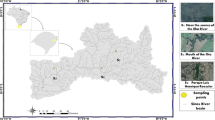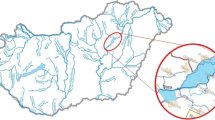Abstract
The concentrations of cadmium, mercury and lead were determined in liver, kidney and feathers of Accipiter gentilis, Buteo buteo and Strix aluco. No significant differences in the concentrations of metals were observed in relation to either age or gender. Cadmium levels in feathers and in kidney were significantly correlated (p < 0.01 or p < 0.05) in all species. In B. buteo, cadmium concentrations in feathers and in liver were also correlated (p < 0.01), as were the concentrations of lead in feathers and in liver (p < 0.05). The low correlation coefficients let to reject the possibility of predicting metals concentrations in viscera from the concentrations in feathers.
Similar content being viewed by others
References
Battaglia A, Ghidini S, Campanini G, Spaggiari R (2005) Heavy metal contamination in little owl (Athene noctua) and common buzzard (Buteo buteo) from northern Italy. Ecotoxicol Environ Safe 60:61–66
Braune BW (1987) Comparison of total mercury levels in relation to diet and molt for nine species of marine birds. Arch Environ Contam Toxicol 16:217–224
Braune BW, Gaskin DE (1987) Mercury levels in Bonaparte’s gull (Larus philadelphia) during autumn molt in the Quoddy region, New Brunswick, Canada. Arch Environ Contam Toxicol 16:539–549
Burger J (1993) Metals in avian feathers: bioindicators of environmental pollution. Rev Environ Toxicol 5:197–306
Burger J, Gochfeld M (1999) Heavy metals in Franklin′s gull tissues: age and tissue differences. Environ Toxicol Chem 18:673–678
Furness RW (1993) Birds as monitors of pollutants. In: Furness RW, Greenwood JJD (eds) Birds as monitors of environmental change. Chapman & Hall, London, p 86
Gochfeld M (1980) Tissue distribution of mercury in normal and abnormal young common terns. Mar Pollut Bull 11:362–377
Gochfeld M, Belant JL, Shukla T, Benson T, Burger J (1996) Heavy metals in laughing gulls: gender, age and tissue differences. Environ Toxicol Chem 15:2275–2283
Goede AA (1985) Mercury, selenium, arsenic and zinc in waders from the Dutch Wadden Sea. Environ Poll A 37:287–309
Goede AA, deBruin M (1984) The use of bird feather parts as a monitor for metal pollution. Environ Pollut 8:281–289
Hughes KD, Ewins PJ, Clark KE (1997) A comparison of mercury levels in feathers and eggs of osprey (Pandion haliaetus) in the North American Great Lakes. Arch Environ Contam Toxicol 33:441–452
Lewis SA, Furness RW (1991) Mercury accumulation and excretion by laboratory reared black-headed gull (Larus ridibundus) chicks. Arch Environ Contam Toxicol 21:316–320
Martin PA, Campbell D, Hughes K, McDaniel T (2008) Lead in the tissues of terrestrial raptors in southern Ontario, Canada, 1995–2001. Sci Tot Environ 391:96–103
Monteiro LR, Granadeiro JP, Furness RW (1998) Relationship between mercury level and diet in Azores seabirds. Mar Ecol- Prog Ser 166:259–265
Ohlendorf HM, Anderson DW, Boellstorff DE, Mulhern BM (1985) Tissue distribution of trace elements and DDE in brown pelicans. Bull Environ Contam Toxicol 35:183–192
Pérez-López M, Hermoso M, López A, Soler F (2008) Heavy metal (Cd, Pb, Zn) and metalloid (As) content in raptors species from Galicia (NW Spain). Ecotoxicol Environ Safe 70:154–162
Stout JH, Trust KA (2002) Elemental and organochlorine residues in bald eagles from Adak Island, Alaska. J Wildlife Dis 38:511–517
Wayland M, Neugebauer E, Bollinger T (1999) Concentrations of lead in liver, kidney, and bone of bald and golden eagles. Arch Environ Contam Toxicol 37:267–272
Zaccaroni A, Amorena M, Naso B, Castellani G, Lucisano A, Stracciari GL (2003) Cadmium, chromium and lead contamination of Athene noctua, the little owl, of Bologna and Parma, Italy. Chemosphere 52:251–1258
Acknowledgments
We thank the staff at the Wildlife Recovery Centres in Galicia, as well as Jesús Santamaría and Marta Prieto Rodríguez of the Servicio de Conservación de la Biodiversidad de la Xunta de Galicia, for help in obtaining samples. This study was partly funded by the Xunta de Galicia within the project “Banco de Especímenes Ambientales de Galicia, 3ª Fase”.
Author information
Authors and Affiliations
Corresponding author
Rights and permissions
About this article
Cite this article
Castro, I., Aboal, J.R., Fernández, J.A. et al. Use of Raptors for Biomonitoring of Heavy Metals: Gender, Age and Tissue Selection. Bull Environ Contam Toxicol 86, 347–351 (2011). https://doi.org/10.1007/s00128-011-0220-4
Received:
Accepted:
Published:
Issue Date:
DOI: https://doi.org/10.1007/s00128-011-0220-4




